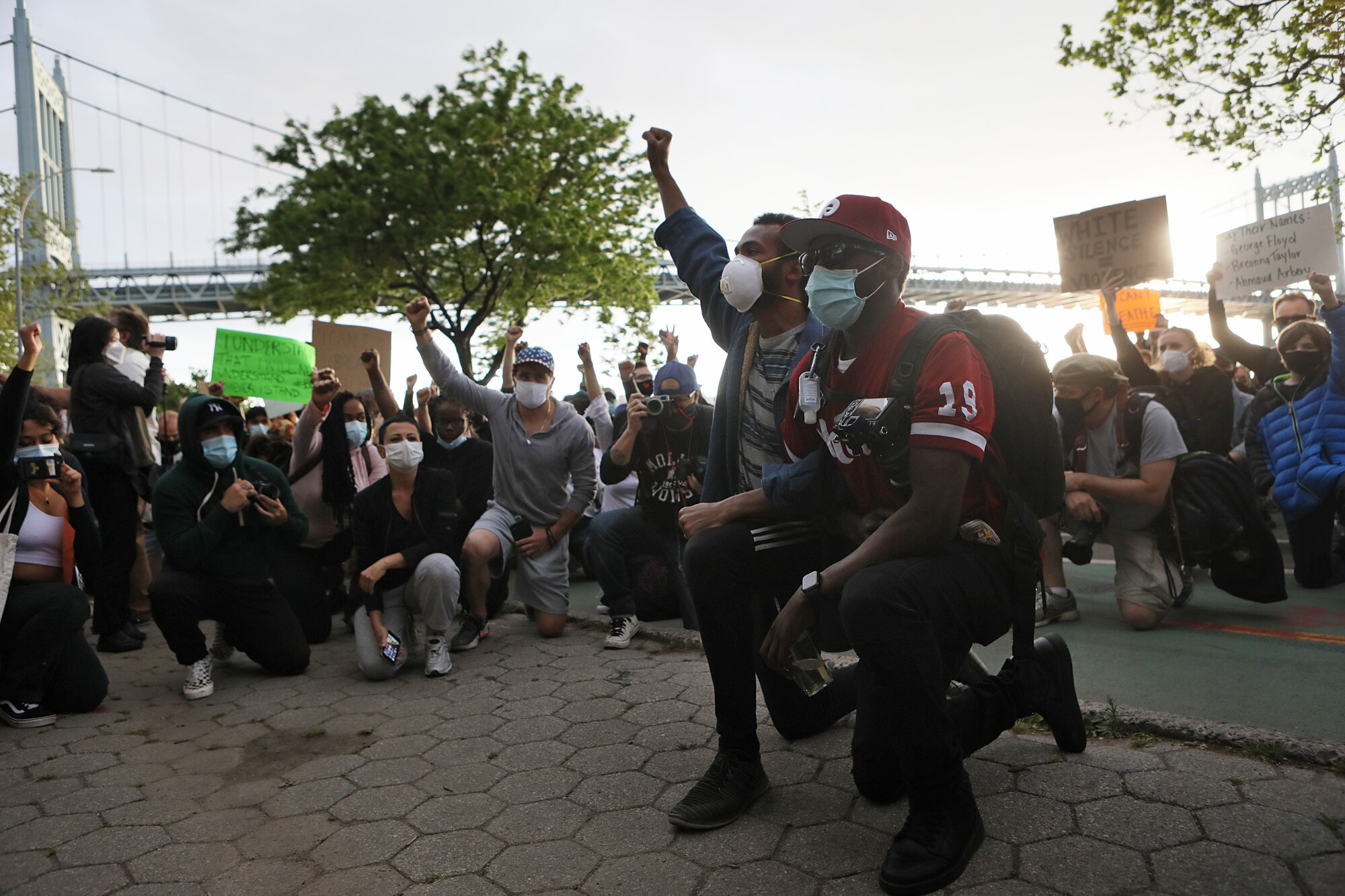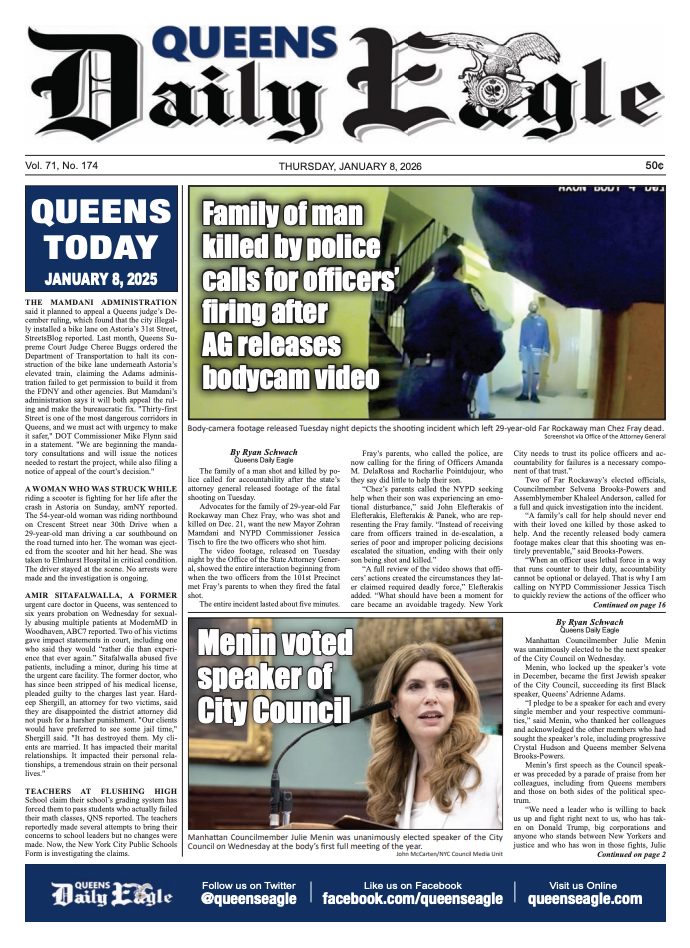Pandemic, protests and politics: These were the stories that defined Queens in 2020
/Demonstrators march in front of the Unisphere during weeks of Black Lives Matter protests in May and June. AP Photo/Seth Wenig
By David Brand
It was a year like no other in a borough like nowhere else in the world.
Queens emerged as an early epicenter of the coronavirus pandemic, with one of the borough’s public hospitals becoming an international symbol of the COVID-19 crisis. In March and April, desperately ill New Yorkers packed the emergency room and critical care units of Elmhurst Hospital, while others sought their first COVID tests in a tent set up outside.
Throughout the pandemic, everyday Queens residents have stepped up for their neighbors in need, often through mutual aid networks that formed in every corner of the borough. Queens’ essential employees, from medical staff to delivery workers, kept New York City running and New Yorkers alive and safe. But the dual health and economic crises have taken their toll on workers and businesses throughout the borough.
As the COVID-19 rate gradually decreased in late spring, activists, leaders and everyday New Yorkers took on another virulent problem: systemic racism against Black and African Americans. Queens residents hit the streets every day for three weeks in the wake of the police killing of George Floyd to demonstrate for accountability and reform.
All of this took place amid a crucial census outreach effort to ensure the borough receives its fair share of federal funding and Congressional representation — a process complicated by the Queens native in the White House.
There were other milestones in 2020, too.
For the first time in 28 years, a new district attorney took office. And Queens elected its first Black male borough president, along with a handful of other trailblazing state lawmakers.
The Wilpon family loosened its grip on the Mets, selling the team to investor Steve Cohen for a professional sports record price of $2.4 billion.
These are the stories that defined Queens in 2020.
New Yorkers line up for COVID tests outside Elmhurst Hospital on March 25. AP Photo/John Minchillo
COVID-19 hits Queens
It was only a matter of time before the “novel coronavirus” made its way to Queens, but few could have foreseen the devastating impact the illness would have.
St. John’s Episcopal Hospital in Far Rockaway treated the borough’s first confirmed case of COVID-19 on Feb. 28. A month later, the pandemic had claimed hundreds of lives, sickened thousands and tested the limits of the borough’s hospitals — a network severely eroded by decades of closures.
Jamaica Hospital was “flooded” with COVID-sick patients, doctors told the Eagle. St John’s was “overwhelmed,” according to the local councilmember. And most famously, Elmhurst Hospital emerged as the “epicenter within the epicenter” of the crisis — a designation that has stuck for the past nine months.
It quickly became clear that, far from being a great equalizer, the virus had a much more devastating impact on immigrant New Yorkers, people of color and low-income residents — disparities evidenced by zip code-specific COVID death and illness data.
The city, state and private institutions built out COVID testing capacity in the borough of 2.3 million people, but glaring gaps remain — particularly in the very neighborhoods hit the hardest.
Elmhurst Hospital environmental services department maintenance worker William Kelly receives the COVID-19 vaccine on Dec. 16. Image via Mayor’s Office
The illness rate decreased enormously through the summer, but by fall had begun to surge once more in several sections of Queens, spurring new state restrictions.
Hope arrived in mid-December, however.
A nurse at Long Island Jewish Medical Center received the nation’s very first COVID-19 vaccine outside of clinical trials on Dec. 14. Two days later, a pair of employees at Elmhurst Hospital became the first two public hospital workers in New York City to get the vaccine.
JACKSON HEIGHTS COMMUNITY LEADER NUALA O’DOHERTY NARANJO DELIVERed GROCERIES, MEALS AND OTHER ITEMS TO NEIGHBORS IN NEED AS PART OF THE COVID CARE NEIGHBORHOOD NETWORK in march. PHOTO COURTESY OF NUALA O’DOHERTY NARANJO
Neighbors help neighbors during unprecedented pandemic
From Astoria to Arverne, Jackson Heights to Jamaica, community members stepped up to help out their neighbors in need access food, medication and other necessities during the pandemic.
Mutual aid networks formed throughout the borough to help people vulnerable to the coronavirus, particularly older adults, avoid travel and remain healthy.
As the economic crisis related to the pandemic worsened, Queens residents continued to look out for one another. Meanwhile, organizations stepped up their food distribution to fight growing food insecurity.
Meanwhile, hospital staff, first-responders, delivery workers and other essential employees kept the borough running — at great risk to themselves and their families.
The Queens Eagle salutes our hometown heroes and we thank you for everything you have done to keep us safe and healthy.
DEMONSTRATORS IN ASTORIA PARK ON JUNE 1. EAGLE PHOTO BY CHRISTINA SANTUCCI.
Movement for Black Lives forces change
The police killing of George Floyd on May 25 touched off weeks of protests across Queens, where Black Lives Matter demonstrators took to the streets to demand an end to racist police violence against Black New Yorkers, funding cuts for the NYPD and the enactment of various police reform measures.
Queens was mostly spared the aggressive crackdown by NYPD officers following a curfew imposed by Mayor Bill de Blasio and a few late-night looting incidents elsewhere in the city. But dozens of people arrested in the Bronx were sent to Queens Central Booking, and at least one person was locked up for a week following his arrest.
No curfew could contain the tens of thousands of New Yorkers who showed up night after night to call out white supremacy and to keep the pressure on policymakers.
The movement achieved major milestones, like forcing state lawmakers back to Albany to repeal 50-a and compelling the City Council to take up a bill criminalizing police chokeholds — nearly six years after the death of Eric Garner, a Black man choked by a cop in Staten Island.
Queens Borough President Donovan Richards was sworn in by NY Attorney General Letitia James earlier this month. Photo courtesy of Borough Hall
Political milestones abound
The year began with an historic inauguration. Queens District Attorney Melinda Katz became the borough’s first newly elected top prosecutor in 28 years when she took office Jan. 1. She is also the first woman to ever hold the position, and just the third female DA in New York City history.
Queens voters went on to elect a number of other trailblazing lawmakers in 2020, including Borough President Donovan Richards, the first Black man to preside at Borough Hall. Richards won the general election in November and took office earlier this month to fill the seat vacated by Katz.
Four other pioneering Democrats won election to state office in November.
Khaleel Anderson, 24, became the youngest Black candidate ever elected to New York state office, and among the youngest ever when he won an open seat to represent Southeast Queens and Far Rockaway in Assembly District 31. He took office immediately after his election win.
Assemblymember-elect Jenifer Rajkumar became the first South Asian woman elected to the state legislature in New York City. She will represent Woodhaven and Glendale in District 38. And Assemblymember-elect Zohran Mamdani is the first South Asian man elected to the Assembly in New York City. He will represent Astoria’s District 36 and is also the first member of the Democratic Socialists of America elected to state office in Queens.
Assemblymember-elect Jennifer Gonzalez-Rojas is the first Latina and first woman of color elected to represent Jackson Heights’ District 34.
And not to be forgotten, Queens also played a role in evicting a native son from the White House.
MR. AND MRS. MET MAKE THEIR WAY INTO CITI FIELD. AP PHOTO/SETH WENIG, FILE
Mets fans rejoice (for a change)
The Wilpon era is over. And, perhaps, a World Series title is on the horizon.
At the very least, Mets diehards are admitting some uncharacteristic optimism after hedge fund billionaire Steve Cohen, a lifelong fan of the club, purchased the team in October.
“When President Nixon announced that the US was finally getting out of Vietnam, a New York radio station played ‘Morning Has Broken’ by Cat Stevens,” said Greg Prince, author and creator of Mets website Fear and Faith in Flushing.
Cohen taking control from the hapless Wilpons is kind of like that, Prince said.
“The darkness that has clouded anything we looked forward to as Mets fans is dissipating at last,” he said. “We can see the light. We don’t know what Met life will be like with Steve Cohen calling the shots and writing the checks, but we knew what it was like with the Wilpons. We’re ready to try something different.”
Shawn Dixon owns Long Island City barbershop Otis & Finn, which was in danger of going under as a result of the COVID-19 pandemic. Eagle photo by David Brand
Businesses struggle to stay afloat and rebuild
For 95 days, Shawn Dixon’s Long Island City barbershop Otis & Finn sat empty, generating zero revenue while saddled with monthly rent payments during the pandemic’s peak.
When the shop reopened, Dixon and his partner sunk another $6,000 into the business to pay for partitions and other COVID prevention supplies. Despite pledges from the city and state to support small businesses, Otis & Finn did not receive government assistance, Dixon said during a July rally outside Queens Borough Hall.
“Small businesses have been asked to carry the entire cost and responsibility of getting this city back on its feet on our backs alone, without any help from the government,” Dixon said. “It is unconscionable. It is immoral.”
Dozens of Queens mom-and-pop shop owners joined Dixon and Queens business leaders that day to call for deeper investments from the city and state.
They said they were struggling to keep their firms afloat without intervention and specifically called on the city to enact commercial rent control, fund more small business disaster loans and enable small companies to access city contracts to supply food to their communities. They also urged elected officials to continue advocating for more federal relief.
The COVID-19 pandemic has devastated thousands of companies across Queens, forcing restaurants and beloved businesses to close permanently.
The pandemic has altered the business landscape in other ways, as well — making hundreds of thousands of jobs remote, increasing our reliance on internet access and even changing the way we dine.











